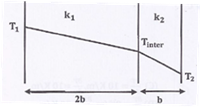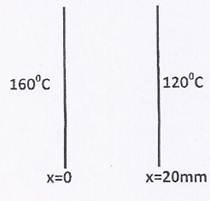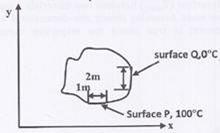Solved GATE Questions on Conduction
Question 1. With an increase in the thickness of insulation around a circular pipe, heat loss to surroundings due to
(A) Convection increases, while that due to conduction decreases
(B) Convection decreases, while that due to conduction increases
(C) Convection and conduction decreases
(D) Convection and conduction increases
GATE-ME-2006
Hint 1. (Ans A)
Question 2. A 100 W electric bulb was switched on in a  size thermally insulated room having a temperature of 20
size thermally insulated room having a temperature of 20 . The room temperature at the end of 24 hours will be
. The room temperature at the end of 24 hours will be
(A) 321
(B) 341
(C) 450
(D) 470
GATE-ME-2006
Hint 2. (Ans D)
Heat generated by bulb
Density of the air 

Volume of the room




Question 3. In a composite slab, the temperature at the interface ( ) between two materials is equal to the average of the temperature at the two ends. Assuming steady one –dimensional heat conduction, which of the following statement is true about the respective thermal conductivities?
) between two materials is equal to the average of the temperature at the two ends. Assuming steady one –dimensional heat conduction, which of the following statement is true about the respective thermal conductivities?

(A) 
(B) 
(C) 
(D) 
GATE-ME-2006
Hint 3. (Ans D)



Consider steady one –dimensional heat flow in a plate of 20 mm thickness with a uniform heat generation of 80 MW/ . The left and right faces are kept at constant temperatures of 160
. The left and right faces are kept at constant temperatures of 160 and 120
and 120 respectively. The plate has a constant thermal conductivity of 200 W/mK.
respectively. The plate has a constant thermal conductivity of 200 W/mK.
Linked Answer Question Q. 4 – Q. 5. Carry two marks Each.
Question 4. The location of maximum temperature with in the plate from its left face is
(A) 15 mm
(B) 10 mm
(C) 5 mm
(D) 0 mm
GATE-ME-2007
Hint 14. (Ans C)



At x=0, T=433 K

At x=20 , T=393 K.
, T=393 K.

For maximum temperature,



Question 5. The maximum temperature with in the plate in  is
is
(A) 160
(B) 165
(C) 175
(D) 250
GATE-ME-2007
Hint 5. (Ans B)


Question 6. A building has to be maintained at 21 (dry bulb ) and 14.5
(dry bulb ) and 14.5 (wet bulb). The dew point temperature under these conditions is 10.17
(wet bulb). The dew point temperature under these conditions is 10.17 . The outside temperature is -23
. The outside temperature is -23 (dry bulb) and the internal and external surface heat transfer coefficients are 8 W/
(dry bulb) and the internal and external surface heat transfer coefficients are 8 W/ and 23 W/
and 23 W/ respectively. If the buildings wall has a thermal conductivity of 1.2 W/mK, then the minimum thickness (in m) of the wall required to prevent condensation is
respectively. If the buildings wall has a thermal conductivity of 1.2 W/mK, then the minimum thickness (in m) of the wall required to prevent condensation is
(A) 0.471
(B) 0.407
(C) 0.321
(D) 0.125
GATE-ME-2007
Hint 6. (Ans B)
Question 7. Steady two-dimensional heat conduction takes place in the body shown in the figure below. The normal temperature gradients over surfaces P and Q can be considered to be uniform. The temperature gradient  at surface Q is equal to 10 K/m. Surface P and Q are maintained at constant tempetratures as shown in the figure, while the remaining part of the boundary is insulated. The body has a constant thermal conductivity of 0.1 W/mK. The values of
at surface Q is equal to 10 K/m. Surface P and Q are maintained at constant tempetratures as shown in the figure, while the remaining part of the boundary is insulated. The body has a constant thermal conductivity of 0.1 W/mK. The values of  at surface P are
at surface P are

(A) ![]()
(B) ![]()
![]()
(C) ![]()
(D) ![]()
GATE-ME-2008
Hint 7. (Ans D)
Direction of heat flow is always normal to surface of constant temperature . So for surface  ,
, 
From energy conservation,
Heat rate at P=Heat rate at Q


1. (A) 2. (D) 3. (D) 4. (C) 5. (B) 6. (B) 7. (D)